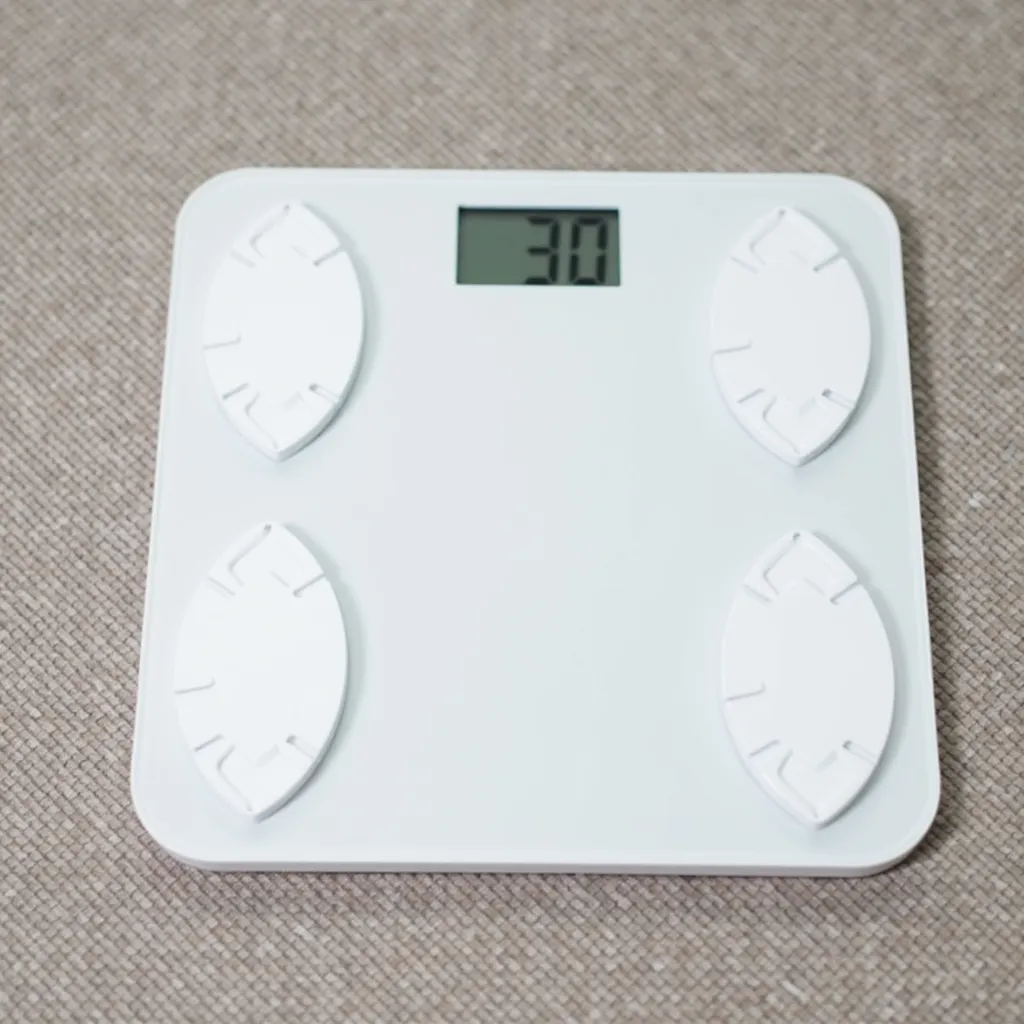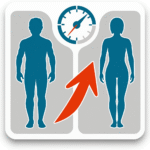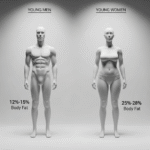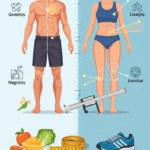Body fat scale online: Discover how to measure your body fat percentage accurately, understand body composition, and make informed health choices
Body Fat Scale Calculator
Calculate your body fat percentage using the U.S. Navy method with our online tool
Measurement Input
Results
Male Body Fat Categories
- Essential Fat: 2-5%
- Athletes: 6-13%
- Fitness: 14-17%
- Average: 18-24%
- Obese: 25%+
Female Body Fat Categories
- Essential Fat: 10-13%
- Athletes: 14-20%
- Fitness: 21-24%
- Average: 25-31%
- Obese: 32%+
Table of Contents
Learn about body fat percentage, a crucial metric that assesses health and fitness by measuring the proportion of fat in total body weight. Discover the significance of understanding body composition - the U.S. Navy Body Fat Formula, and how to accurately calculate your body fat percentage using accessible online tools. Explore the implications of different body fat categories for males and females. Gain insights into your health and fitness decisions, and find out how professional guidance can enhance your understanding of body fat and overall wellness.
Introduction to Body Fat Percentage
Body fat percentage is a critical metric that measures the proportion of fat in relation to the total body weight. Understanding this percentage is essential for individuals seeking to assess their overall health and fitness. Unlike just looking at weight on a scale, body fat percentage provides a more accurate picture of body composition, distinguishing between fat mass and lean mass, which includes muscles, bones, and organs.
Monitoring body fat percentage holds significant importance in various health aspects. A higher body fat percentage may indicate an increased risk of health issues, such as cardiovascular disease, diabetes, and certain cancers, whereas lower levels may correlate with better metabolic health. Regularly assessing body fat allows individuals to track changes in their physique, particularly during weight loss or fitness training, ensuring that muscle is preserved while fat is reduced.
For many embarking on a fitness journey, understanding body fat composition can be more informative than simply aiming for a specific weight goal. Recognizing how body fat impacts performance, energy levels, and overall well-being informs better decision-making regarding diet, exercise regimens, and lifestyle choices. Furthermore, body fat percentage varies by age, sex, and genetics, making personalized goals essential to achieving optimal health.
Utilizing tools and methods, such as the U.S. Navy Method for calculating body fat percentage, empowers individuals to gain realistic insights into their body composition. This knowledge often serves as motivation for sustained healthy habits, as it accentuates the importance of a balanced approach towards fitness and nutrition over merely focusing on the scale.
Understanding the U.S. Navy Body Fat Formula
The U.S. Navy Body Fat Formula is a widely recognized method for estimating an individual's body fat percentage based on specific body measurements. Developed by the U.S. Navy in the late 20th century, the formula was designed to evaluate the body composition of military personnel efficiently and accurately. Unlike methods such as hydrostatic weighing or skinfold measurements, which may require specialized equipment or trained professionals, the Navy's formula relies on easily obtainable measurements, such as height, weight, neck circumference, and waist circumference.
The formula is validated through various studies, showing a high degree of accuracy when comparing the estimated body fat percentage against more complex measurement techniques. This validation is essential for a method utilized in health assessments and military standards, ensuring that it provides reliable results. The ease of use and accessibility has led to its widespread application not only within military contexts but also among fitness enthusiasts and health professionals.
To calculate body fat percentage using the U.S. Navy method, individuals must measure their height, weight, neck, and waist circumferences. In some cases, hip measurement is also included for women to provide a more nuanced estimate. The underlying principle of the formula is that body fat distribution varies among individuals, influenced by factors such as age, sex, and genetics. Therefore, the formula accounts for these variables to enhance estimation accuracy.
This user-friendly approach allows individuals to monitor their health and fitness progression over time. By using the U.S. Navy Body Fat Formula, one can gain valuable insights into their body composition, enabling informed decisions regarding diet and exercise regimens. Consequently, it remains a prevalent choice for estimating body fat percentage due to its balance of precision and practicality in various settings.
Using Our Body Fat Scale Online
Calculating body fat percentage has become increasingly accessible thanks to online tools. Our U.S. Navy Method Tool is straightforward and user-friendly, allowing you to efficiently assess your body composition. To effectively utilize this Body Fat Scale Online. Follow these steps to ensure accurate results.
To begin, gather the necessary inputs. The U.S. Navy Method requires specific measurements: your height, neck circumference, waist circumference, and, for women, hip circumference. It is essential to use a tape measure for accuracy. Measure your waist at its narrowest point and your neck just below the Adam's apple. For women, the hip measurement should be taken at the fullest part of the hip. Recording these numbers carefully is vital to ensure the precision of the body fat percentage calculation.
Once you have obtained the measurements, navigate to our online body fat scale calculator. You will find input fields where you can enter the gathered data. It is important to select your gender appropriately, as the calculation differs for men and women. Enter the measurements in inches or centimeters, depending on the calculator's requirements. Make certain that there are no discrepancies or typos, as these can lead to inaccurate outputs.
After entering your data, click on the calculate button. The tool will process your inputs and generate your body fat percentage along with an interpretation of the results. This calculation can give you valuable insights into your body fat levels and assist in setting health and fitness goals. Understanding your body composition is crucial, as it plays a significant role in overall health. Utilizing the U.S. Navy Method Tool, therefore, can be a beneficial step in your wellness journey.
Required Measurements for Calculation
To accurately calculate your body fat percentage using the U.S. Navy Method, gathering precise measurements is essential. The key measurements required include height, neck circumference, waist circumference, and hip circumference. Below, we will delve into the process of obtaining these measurements correctly.
Height: Measure your height without shoes, standing straight against a wall. Position a flat object, such as a ruler or a book, on top of your head until it rests against the wall. Use a measuring tape or a yardstick to determine the distance from the floor to the base of the object. Record your height in inches or centimeters based on your preference.
Neck Circumference: To measure your neck circumference, stand straight while looking forward. Using a flexible measuring tape, wrap it around the base of your neck, just above your collarbone. Ensure the tape is snug but not tight. Record the measurement, which should be expressed in inches or centimeters.
Waist Circumference: For waist measurement, locate your natural waistline, typically just above your navel. Again, use the flexible measuring tape to take the measurement around your waist, ensuring that the tape is parallel to the floor and fits comfortably without pressing into the skin. This figure should be recorded in the same units as previously noted.
Hip Circumference: Measure your hip circumference by standing with your feet together. Place the measuring tape around the widest part of your hips. Ensure that the tape is level and not too tight. This critical measurement should also be noted in inches or centimeters.
Taking the time to ensure accuracy in these measurements is crucial, as errors can lead to miscalculations in your body fat percentage. It is advisable to repeat each measurement twice, considering the average of the two for the most reliable results.
Body Fat Percentage Categories for Males
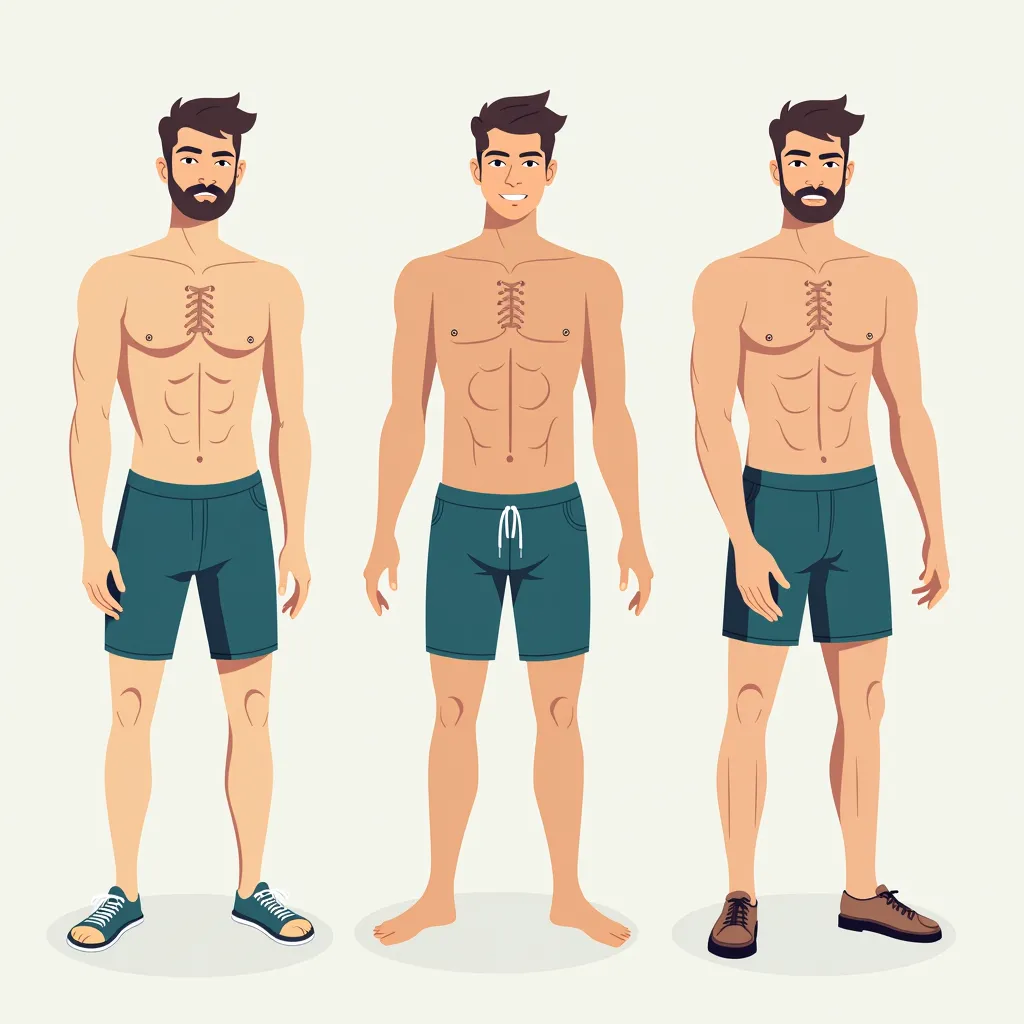
Understanding body fat percentage is crucial for men aiming to maintain optimal health. The U.S. Navy Method Tool provides an effective means to calculate body fat, enabling individuals to categorize their results into five distinct ranges: essential fat, athlete, fitness, average, and obese. Each category offers insights into the implications of body fat levels on overall well-being.
Essential fat is the minimum amount necessary for survival and is typically considered to be around 2-5% of total body weight for men. This fat plays a vital role in physiological functions, including hormone regulation and vitamin absorption. Achieving this range suggests that an individual has a healthy, essential fat level, fundamental for maintaining bodily functions.
The athlete category generally encompasses body fat percentages ranging from 6-13%. Men within this range often engage in rigorous physical training and showcase a lean physical appearance. This low body fat percentage can positively correlate with enhanced athletic performance, although it may not be sustainable or necessary for the average individual.
In the fitness category, which is classified between 14-17%, individuals possess a balanced, healthy body fat level. Men in this range typically include those who exercise regularly and prioritize physical health but may not train at an elite competitive level. This category illustrates a good blend of muscle and body fat, supporting better metabolic health.
The average body fat percentage falls within the 18-24% range. While still considered acceptable, individuals in this category may need to pay closer attention to their health as they could be at risk for various health issues associated with higher body fat levels.
Finally, the obese category, representing a body fat percentage of 25% or higher, is associated with significant health risks, including cardiovascular disease, diabetes, and other chronic conditions. Men in this category are encouraged to assess their lifestyle choices and implement strategies to lower their body fat percentage for better health outcomes.
Body Fat Percentage Categories for Females
Understanding body fat percentage is crucial for women seeking to gauge their health and fitness levels. Using the U.S. Navy Method, female body fat percentages can be categorized into five distinct groups: essential fat, athlete, fitness, average, and obese. Each category provides insight into different levels of body composition, facilitating informed health choices.
Essential fat represents the minimum amount of fat necessary for basic physiological functions, typically ranging from 10% to 13% for females. This category is critical for healthy hormonal balance, reproductive functions, and overall vital organ protection. Women falling into this category generally possess a lean physique and optimal health.
The athlete category, which encompasses body fat percentages from 14% to 20%, is characterized by individuals who engage in rigorous physical training. Female athletes in this group usually exhibit heightened musculature and lower levels of body fat, contributing to improved performance in sports and physical activities.
For those in the fitness category, body fat percentages usually range from 21% to 24%. Women in this group often maintain a healthy lifestyle through regular exercise and balanced nutrition. They are generally perceived as being in good shape, achieving a balance between aesthetic appearance and health.
The average category includes body fat percentages from 25% to 31%. This range indicates a normal body composition for many women, balancing health and lifestyle factors. While it is not necessarily undesirable, awareness of one’s body fat percentage is essential for making informed health decisions.
Lastly, the obese category encompasses women with body fat percentages above 32%. This group may face increased health risks, including cardiovascular diseases and metabolic disorders. Understanding where one stands within these categories can motivate women to make necessary lifestyle adjustments for improved health outcomes.
Interpreting Your Results
Upon receiving the results from the body fat percentage calculator, it is essential to comprehend what the figures mean for your overall health. Body fat percentage serves as a critical indicator of physical fitness, influencing various aspects of well-being. Generally, healthy body fat percentages range from 10-20% for men and 18-28% for women, but these values may vary based on age, fitness levels, and individual health conditions.
Understanding your body fat percentage allows you to assess where you stand within these ranges. A percentage falling below the recommended levels could signify undernourishment or excessive physical activity, while a high percentage may indicate an increased risk for chronic diseases such as diabetes, heart disease, and hypertension. It is prudent to consider these results alongside other health metrics, such as Body Mass Index (BMI), dietary habits, and physical activity levels, to achieve a holistic understanding of your health status.
Additionally, lifestyle choices significantly impact body fat percentage. For example, a balanced diet rich in whole foods and regular physical activity can aid in maintaining a healthy body composition. Conversely, unhealthy eating habits and sedentary lifestyles can lead to an elevated body fat percentage over time. Therefore, it is vital to not only assess your results but also to contemplate actionable steps towards improving your overall health.
Ensuring regular monitoring of your body fat percentage can help guide your fitness journey. Adjustments in diet or exercise regimes may become necessary based on the information obtained from the calculator. By understanding the implications of your body fat percentage, you can make informed decisions that promote long-term wellness and reduce health risks.
Limitations of the Body Fat Scale Calculator
The body fat scale calculator, while a convenient tool for estimating body fat percentage, possesses several inherent limitations that users should consider. One primary concern is the individual variation in body composition. Factors such as muscle mass, bone density, and the distribution of fat can significantly affect the accuracy of the measurements provided by these scales. For instance, individuals with higher muscle mass may be categorized as having a lower body fat percentage than their actual figures due to the scales' reliance on electrical impedance. Thus, a person who is fit and muscular might be inaccurately assessed as having a higher body fat percentage.
Another noteworthy limitation is the calibration and technology of the scale itself. Different brands and models can yield varying results, leading to discrepancies in measurements from one use to another. Furthermore, the moisture level in the skin and hydration status can affect the readings since these scales operate based on the conductivity of body tissues. When users are dehydrated, body fat percentages may skew unexpectedly, presenting challenges in reliability and consistency.
Additionally, the body fat scale calculator does not account for fat distribution. Body fat is not uniformly distributed; thus, individuals may have varying health risks based on where their fat is stored, regardless of the overall percentage indicated by the scale. Relying exclusively on this method may lead to an incomplete understanding of an individual’s health. Health professionals often recommend a more comprehensive approach that includes various assessment methods such as skinfold measurements, imaging techniques, or bioelectrical impedance analysis, alongside the body fat scale calculator. Such an integrative strategy can provide a more accurate depiction of an individual's overall health and body composition.
Seeking Professional Guidance
When it comes to understanding and managing body fat percentage, consulting healthcare professionals can provide invaluable support and personalized assessments tailored to individual needs. While tools like the U.S. Navy Method are helpful for estimating body fat percentage, they may not account for unique variables inherent to each person. This is particularly important for individuals at different life stages, athletes, and those with pre-existing health conditions.
For athletes, body fat percentage can significantly impact performance. A professional can offer advice on how to achieve optimal body composition, factoring in training modalities and competition requirements. Similarly, individuals with specific health issues, such as obesity or metabolic disorders, can benefit immensely from professional counsel. A healthcare provider can evaluate underlying health concerns and create an appropriate plan to improve body composition safely.
Moreover, psychological factors play a pivotal role in health. Professionals can provide guidance on setting realistic goals and cultivating a positive mindset towards body image. They can help individuals navigate challenges related to weight loss or maintenance, ensuring that changes are sustainable rather than drastic. Furthermore, obtaining a professional opinion can reveal potential health risks associated with current body fat levels, instigating timely interventions.
In summary, while self-assessment tools are practical for gauging body fat percentage, they cannot replace the tailored advice of healthcare experts. From individual evaluations to support in establishing healthy living strategies, consulting a professional can enhance your health journey significantly. These experts provide not only measurable assessments but also crucial psychological and nutritional advice aimed at promoting overall well-being.
In conclusion, understanding body fat percentage is essential for anyone looking to improve their health and fitness journey. By delving into body composition and utilizing reliable methods such as the U.S. Navy Body Fat Formula, you can gain a clearer picture of your overall well-being. The ability to accurately calculate your body fat percentage with online tools empowers you to make informed choices about your lifestyle. Different body fat categories offer valuable insights tailored to both males and females, helping you set realistic goals. Take charge of your health today by exploring these resources and seeking professional guidance to optimize your fitness plan.
